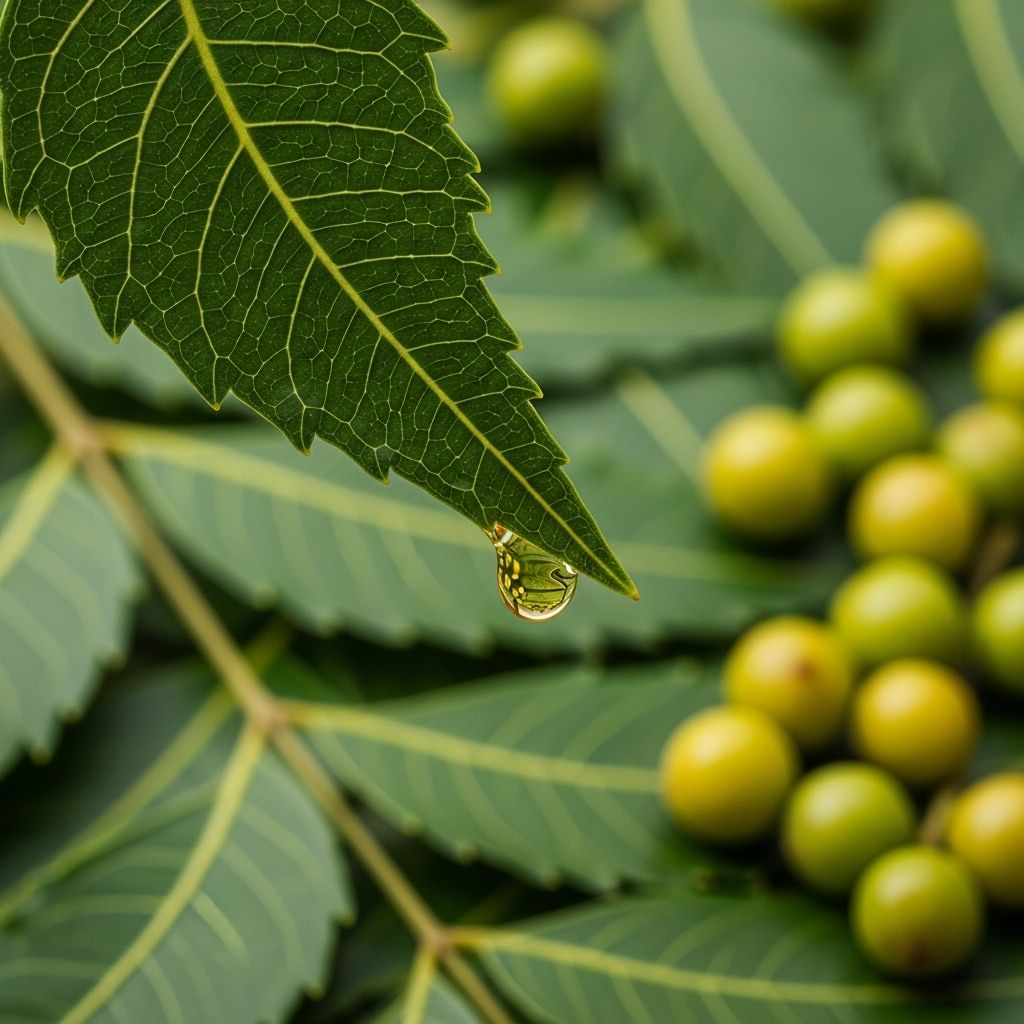Neem Oil in the Garden: Uses, Benefits, Risks, and Practical Tips
Harness nature’s potent pest-fighting power while safeguarding your garden’s delicate ecosystem.

Neem Oil in the Garden: Essential Uses, Benefits, Risks, and Application Tips
Neem oil is a versatile, natural pesticide, extracted from the seeds and fruit of the neem tree (Azadirachta indica), making it a foundational asset in the organic gardener’s toolkit. Renowned for controlling pests, fungus, and harmful bacteria, neem oil is widely recommended by gardening experts for safe and sustainable plant care. However, optimal results and safety depend on informed use, so understanding neem oil’s unique properties, benefits, risks, and best practices is critical for both new and seasoned gardeners.
Contents
- What Is Neem Oil?
- How Neem Oil Works in Pest & Disease Control
- Neem Oil vs. Horticultural Oil: Key Differences
- Drawbacks and Safety Concerns
- How To Apply Neem Oil
- Neem Oil Recipes and Dosing
- Frequently Asked Questions (FAQ)
What Is Neem Oil?
Neem oil is an organic, plant-derived compound pressed from the seeds and fruit of the neem tree, indigenous to India and other tropical regions. The oil is yellow-brown, slightly bitter, and has a distinct garlic-sulfur smell. Its main bioactive component, azadirachtin, is responsible for its pest-repellent and insect growth-inhibiting effects.
- Neem oil is available in pure (cold-pressed) and processed (clarified, extracted) forms.
- It is commonly sold as ready-to-use sprays, concentrates, or wettable powders in garden supply stores.
- Pure, cold-pressed neem oil contains higher concentrations of azadirachtin and is more effective for pest management.
Growing neem trees offers additional garden benefits, such as shade, nitrogen-fixing, and soil improvement through neem seed meal—often used as a fertilizer.
How Neem Oil Works in Pest and Disease Control
Neem oil is not a contact killer; instead, it disrupts the reproductive, hormonal, and feeding cycles of more than 200 types of insect pests. It acts as both a preventive and active agent against pest infestations and plant diseases.
- Azadirachtin: Inhibits insect molting, feeding, egg-laying, and growth.
- Antifungal Properties: Suppresses powdery mildew, black spot, rust, and many other fungal pathogens.
- Antibacterial Effects: Disrupts bacteria responsible for plant diseases.
- Biofungicide: Used as an organic alternative in disease prevention protocols.
Neem oil is most effective if applied as a preventive measure, yet it can help control active outbreaks. For instance, it can reduce nematode populations in soil, inhibit bacteria that cause harmful nitrification, and supercharge soil nitrogen retention.
List of Pests Controlled by Neem Oil
- Whiteflies
- Aphids
- Mealybugs
- Spider mites
- Leafminers
- Japanese beetles
- Fungus gnats
- Thrips
- Scale insects
Neem oil also targets fungal issues such as:
- Powdery mildew
- Downy mildew
- Rust
- Black spot
- Leaf spot
Neem Oil vs. Horticultural Oil: Key Differences
Both horticultural oil and neem oil are derived from plants. However, neem oil is a specific type of horticultural oil, classified as an all-season oil, with a unique active ingredient that sets it apart.
| Characteristic | Neem Oil | Horticultural Oil (General) |
|---|---|---|
| Source | Neem tree seeds/fruits | Various plant/vegetable oils |
| Active Ingredient | Azadirachtin | Oil, often no bioactive compound |
| Action | Insecticidal, antifungal, biofungicide | Primarily smothering/suffocating pests |
| Seasonal Use | All-season | Often dormant season |
| Pest Control | Active disruption of pest cycles | Contact smothering effects |
| Certifications | OMRI-listed for organic gardening | Varies |
While horticultural oils work best as a preventive shield, neem oil actively disrupts pest reproduction and growth—hence its popularity for both prevention and treatment in integrated pest management (IPM).
Drawbacks and Safety Concerns
Despite its broad-spectrum efficacy, improper neem oil use can harm plants, beneficial insects, and the surrounding environment. Awareness of its risks is essential for safe application:
- Phytotoxicity: Overapplication or spraying during high heat and direct sunlight may burn sensitive leaves or cause stunted growth.
- Beneficial Insects: Although neem is safer than synthetic pesticides, excessive use may still impact bees, butterflies, and predatory insects.
- Human and Animal Safety:
- Concentrated neem oil can irritate skin, eyes, and lungs if mishandled or inhaled.
- Wettable powders pose a risk of blowback and inhalation during preparation.
- Children and pets are more sensitive to neem oil exposure; keep containers out of reach.
- Neem oil should not be used around fish or amphibians, as it may be toxic in aquatic settings.
- Mild Environmental Risks: When used according to label rates, neem oil poses minimal risk to birds and soil health.
- Effectiveness: Neem oil is not a quick contact killer. It works over time and may not provide immediate results for severe infestations.
- Expense: Compared to some natural alternatives (e.g., natural pyrethrin), neem oil sprays can be significantly more expensive per application.
Always wear gloves, goggles, and a mask when handling concentrated neem, and avoid spraying on windy days or when pollinators are active.
How To Apply Neem Oil
Proper application is key to maximizing neem oil’s benefits and minimizing its risks:
- Best Time to Apply: Early morning or late afternoon/evening, to avoid strong sunlight.
- Frequency: Every 7–14 days for prevention; every 4–7 days for active infestations (read product labels).
- Coverage: Spray thoroughly on leaf surfaces (top and underside) and stems. Target infected and adjacent healthy plants.
Step-by-Step Neem Oil Spray Application
- Wear protective gloves, clothing, and eyewear.
- Mix neem oil according to concentration instructions (see below).
- Pour into a clean, well-labeled spray bottle.
- Spray evenly on affected plants until run-off.
- Repeat as needed, observing for signs of phytotoxicity.
Avoid spraying during hot, sunny periods or on stressed plants, as this increases the risk of leaf burn.
Neem Oil Recipes and Dosing
Neem oil must be emulsified to mix with water. The classic recipe is:
- 1–2 tsp pure, cold-pressed neem oil
- 1 tsp mild liquid soap (acts as an emulsifier)
- 1 quart (32 oz) of warm water
Mix the soap and neem oil first, then dilute with water, and shake well before spraying. Adjust ratios as indicated for larger garden volumes:
- For a 1-gallon sprayer: 1–2 tablespoons neem oil, 1 tablespoon soap, 1 gallon water.
- Wettable powders: Follow package instructions, avoiding inhalation.
Store any leftover spray in a cool, dark place, but use within 8 hours for best results—neem oil breaks down quickly in water.
Frequently Asked Questions (FAQ)
Q: Is neem oil safe for all plants?
A: Neem oil is generally safe for most garden plants when applied at recommended rates. However, some sensitive species (e.g., herbs like basil, chives, cilantro; seedlings; certain ornamentals) can be damaged by overapplication or excessive sunlight during use. Patch test before widespread application.
Q: How soon can I harvest after neem oil application?
A: Neem oil is safe to apply up to harvest day for fruits, vegetables, and herbs. Always wash produce thoroughly to remove surface residues.
Q: Will neem oil harm bees and pollinators?
A: Neem oil is less toxic than synthetic pesticides but can still affect pollinators if sprayed directly. Apply during hours when pollinators are least active (evening or early morning) for best safety.
Q: Does neem oil kill the eggs of insects?
A: Neem oil disrupts insect reproduction, inhibiting eggs’ viability and larvae development, but it does not reliably kill existing eggs on contact.
Q: Can I use neem oil indoors?
A: Yes, neem oil can be used on houseplants for pest and fungal control. Ensure good ventilation and avoid runoff onto furniture; test sensitivity on a few leaves before general use.
Q: Why does neem oil stink?
A: Pure neem oil has a pungent odor, often compared to garlic and sulfur. Diluted sprays minimize the smell, but odor dissipates as the oil dries.
Q: Why didn’t my neem oil spray work?
A: Possible reasons include incorrect dilution, not emulsifying the oil, using a poor-quality or expired product, spraying during harsh sunlight, or dealing with resistant pest species. Repeat treatments and consistency are crucial for effective control.
Best Practices and Tips for Neem Oil Use in the Garden
- Always start with a patch test on small sections of the plant.
- Mix neem oil spray fresh before each use to ensure potency.
- Avoid spraying on flowers to protect pollinators.
- Never exceed recommended concentrations; more is not better and can cause damage.
- Rinse edible crops before eating or cooking, even when using organic sprays.
- Store concentrated neem oil in a cool, dark place to preserve shelf life.
- Dispose of unused spray solution safely; avoid pouring into bodies of water.
- Record spray dates and effects to fine-tune your IPM approach.
Summary: Key Takeaways
- Neem oil is a powerful plant-based tool for controlling garden pests and diseases, with additional soil health benefits.
- Proper application is essential: mix correctly, time treatments wisely, and avoid overdose or unsafe conditions.
- Watch for drawbacks: possible phytotoxicity, risk to beneficial insects, expense, and mild toxicity for aquatic organisms.
- Neem oil is suitable for use up to harvest but always wash edibles thoroughly.
- Integrate neem oil with other organic gardening practices for best results.
References
- Epic Gardening Founder Kevin Espiritu’s Neem Oil Guide.
- Epic Gardening’s Horticultural Oil Comparison.
- User commentary and testing on neem oil efficacy.
References
Read full bio of Anjali Sayee












